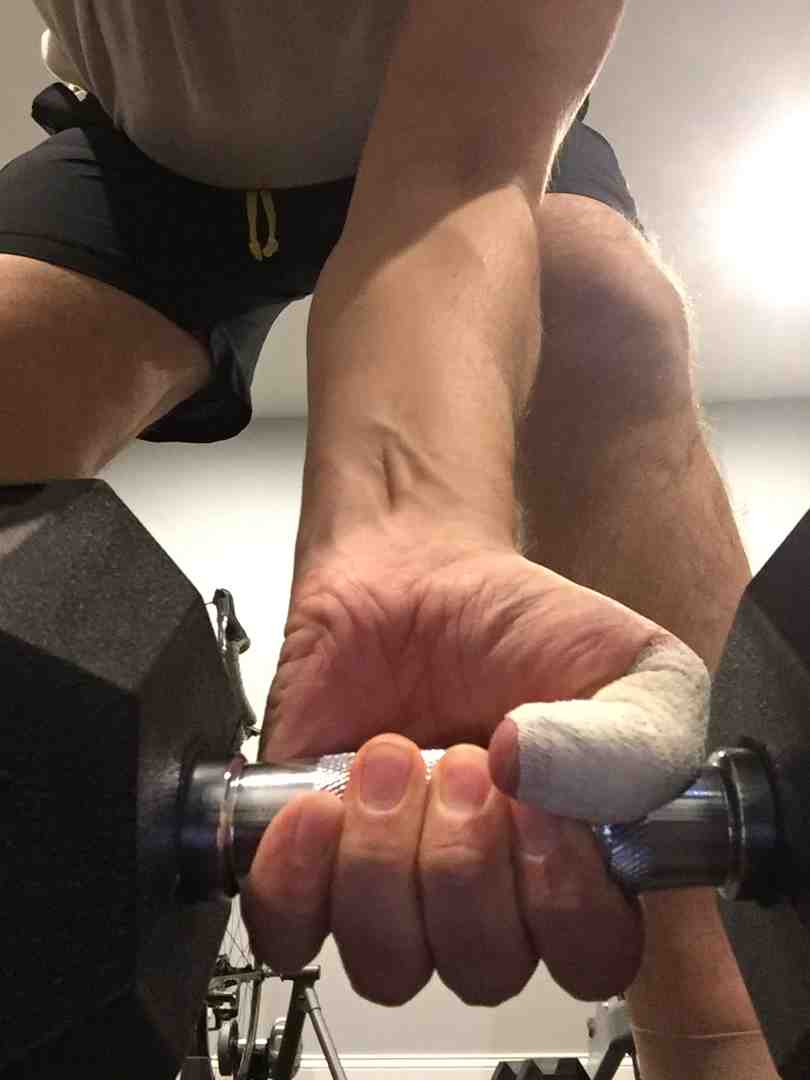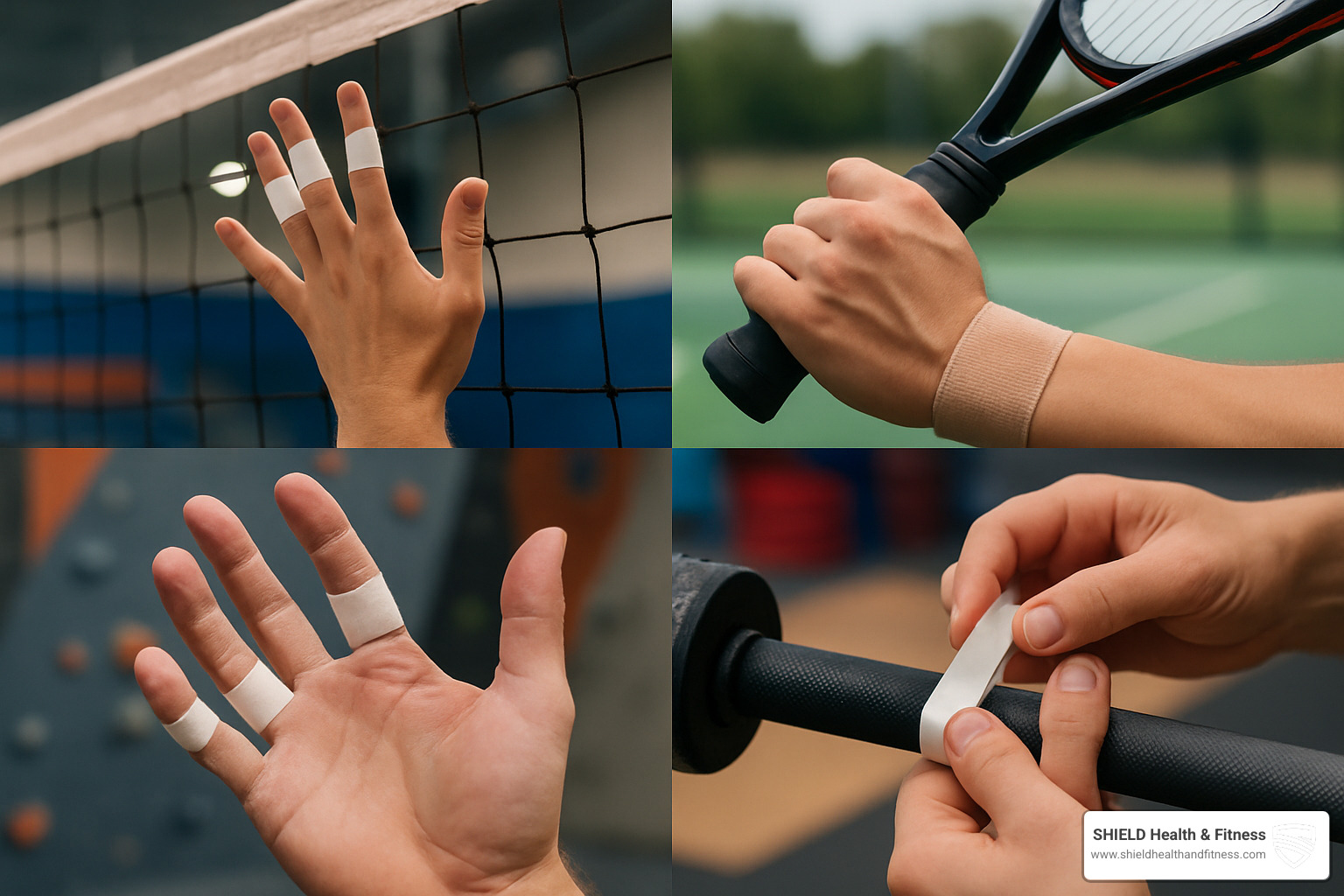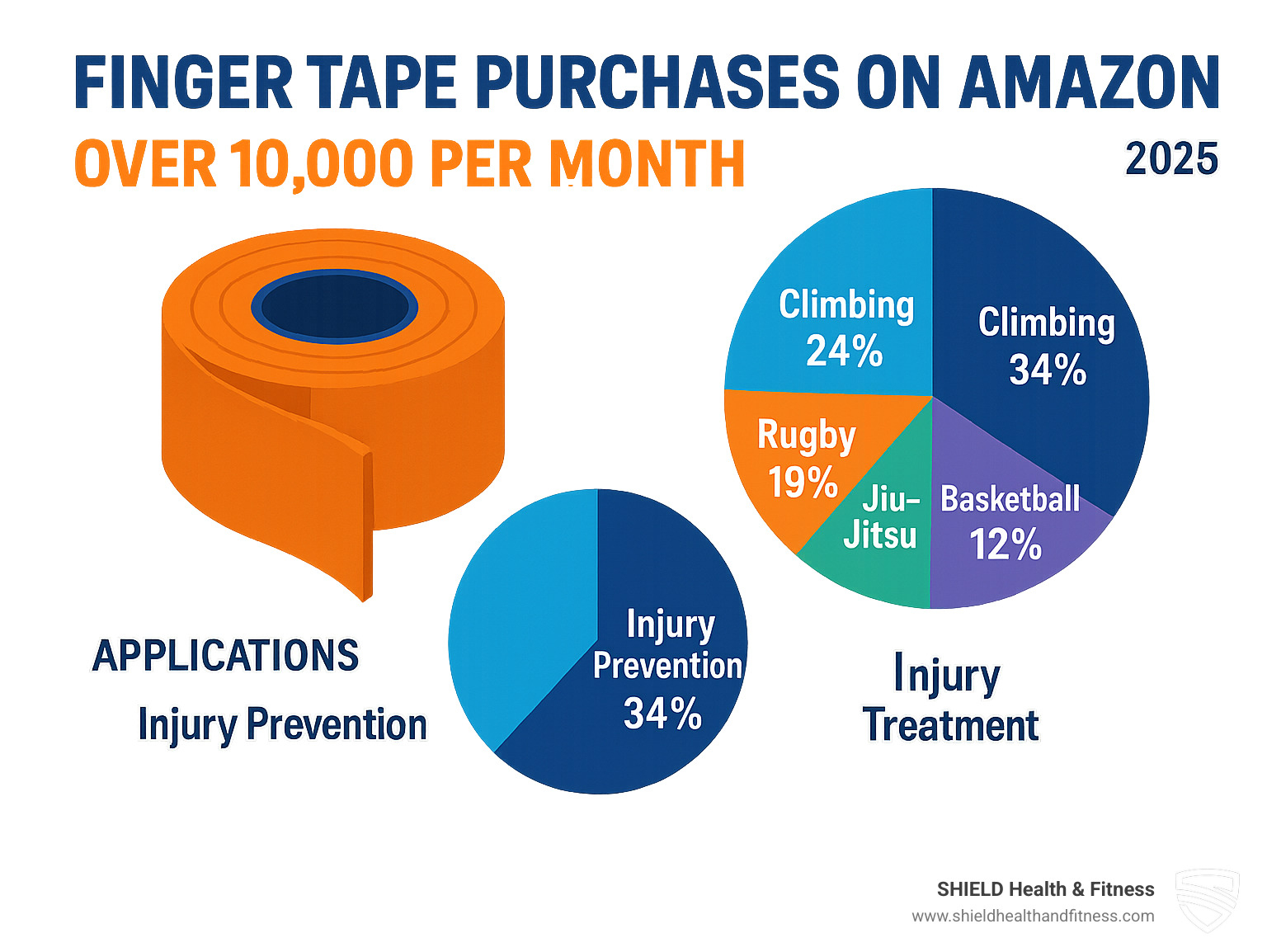Get a Grip – The Ultimate Hand Taping Guide
Why Your Hands Need Athletic Tape Protection
Athletic tape for hands is a game-changer for athletes who want to prevent injuries, support healing, and boost performance. Whether you're protecting against blisters, supporting a sprained finger, or improving your grip strength, the right taping technique can keep you in the game.
Quick Guide to Athletic Tape for Hands:
- Rigid tape - Prevents movement, and gives maximum compression.
- Elastic tape - Allows more range of motion (ROM); flexible support and blister protection
- Kinesiology tape - Allows maximum ROM; used for 24 hour wear and recovery
- Common applications - Finger sprains, thumb injuries, wrist support, grip improvement
- Safe wear time - 24 hours for rigid or elastic tape, 3-5 days for kinesiology tape
Your hands take a beating in sports. From volleyball spikes to weightlifting calluses, the terminal part of the upper limb is clearly 'the tool' most subjected to stresses during athletic activities. Professional athletes across sports like rock climbing, jiu jitsu, volleyball, basketball, and baseball rely on quality tape to protect their most valuable assets.
Over 10,000 units of finger tape products are purchased monthly on Amazon alone. Athletes aren't just buying tape for injuries anymore - they're using it proactively to prevent problems before they start.
Different sports demand different approaches. Tennis players focus on grip improvement and blister prevention. Climbers need skin protection and improved friction. Weightlifters require thumb support for hook grip techniques.
I'm Josh Key, and I've spent years working with athletes to test and develop athletic tape solutions at Shield Health and Fitness. Through product demonstrations with professional athletes and extensive field testing, I've seen how proper athletic tape for hands can transform an athlete's confidence and performance.

Athletic Tape Types Demystified
Choosing the right athletic tape for hands becomes simple once you understand how each type works.
Rigid tape is your protective bodyguard. This non-stretch powerhouse locks joints in place when you need maximum stability. When you're worried about hyperextending a joint or need rock-solid support during heavy lifting, rigid tape delivers that "locked and loaded" feeling.
Elastic tape stretches with your movements while providing steady compression and support. This flexibility makes it perfect for athletes who need protection without feeling restricted. The gentle compression helps control swelling while maintaining healthy blood flow.
Kinesiology tape creates a microscopic lift on your skin that some healthcare practitioners say improves circulation and lymphatic drainage. Recent research shows that kinesiology tape applied with proper tension can actually boost agility performance after just 48 hours. It's particularly effective for pain relief and supporting your body's natural healing process. for joints and the hands, we find kinesiology tapes are particularly useful in helping proper neutral alignment outside of workouts, supporting alignment and posture.
Quality tape features porous construction with thousands of tiny holes that let your skin breathe and reduce sweaty, uncomfortable feelings during intense workouts. This breathability helps the tape stick better when you're pushing hard.
Adhesive strength varies dramatically between tape types. Rigid tape uses aggressive adhesives for maximum hold, while kinesiology tape uses gentler formulations that protect your skin during extended wear. All quality tapes should be latex-free to reduce allergy risks.
For hand applications, ½ and 1 inch width tapes work perfectly for individual fingers, while 1.5-2 inch tape provides optimal coverage for wrist and thumb support.
Our comprehensive guide on Athletic Tape for Injuries dives deeper into selecting the right tape for your specific situation.
| Tape Type | Best For | Stretch | Wear Time | Key Benefits |
|---|---|---|---|---|
| Rigid | Joint stability, injury prevention | 0% | up to 24 hours | Maximum support, restricts motion |
| Elastic | Flexible support, compression | 25-75% | 2-3 days maximum | Movement with support, swelling control |
| Kinesiology | Pain relief, circulation | 10-50% | 3-5 days or more | Skin lift, improved blood flow, alignment support |
How Each Tape Works on Skin & Joints
Mechanical support creates an external ligament system that prevents dangerous movements while allowing safe motion. When you tape a finger joint, you're giving it a safety net that catches potentially harmful movements before they cause damage.
Proprioception improvement is where tape becomes fascinating. Tape provides continuous sensory feedback that sharpens joint awareness, helping you make tiny adjustments that prevent injury and improve performance.
The micro-lift effect is kinesiology tape's unique and somewhat controversial specialty. By gently lifting the skin, this tape creates space for improved fluid movement. This improved circulation delivers more oxygen and nutrients while helping flush out metabolic waste that causes fatigue. Research on this is mixed, which is why we like Kinesiology tape most for it's alignment and postural support capabilities.
Circulation benefits vary between tape types. While rigid tape focuses on mechanical support, elastic and kinesiology tapes promote blood flow, which becomes valuable during recovery.
Why & When to Use Athletic Tape for Hands
Your hands are your connection to every piece of equipment you touch. When they're compromised, your entire game suffers. Understanding when and why to use athletic tape for hands can be the difference between sitting on the sidelines and dominating your sport.
Sprain support is the most obvious reason athletes reach for tape. When you've rolled a finger joint or hyperextended your thumb, tape becomes your external ligament system, holding everything in place while your body heals.
Tendonitis relief is where tape really shines for chronic issues. If you're dealing with De Quervain's syndrome (that nagging thumb pain), proper taping can reduce stress on angry tendons. The Kinetic Taping for Hand Pain technique has helped countless athletes manage this condition.
Blister prevention creates a protective barrier that reduces friction between your skin and whatever you're gripping. Ask any serious climber or rower - torn calluses can end a training session instantly.
Grip improvement isn't just about preventing slips. When you're confident in your grip, your entire technique improves. Scientific research on kinesiology tape agility shows measurable performance improvements when athletes feel secure and supported.
Swelling control becomes crucial when dealing with chronic conditions or recovering from injury. The gentle compression from elastic tape helps manage inflammation without restricting function.
Arthritis support can reduce pain and stiffness enough to keep you in the game. It's not a cure, but it can buy you quality training time while working on long-term solutions.
Key Injuries Athletic Tape for Hands Protects
Jammed fingers are classic ball sport injuries. When a finger gets bent backward or sideways, buddy taping the injured finger to a healthy neighbor provides support while allowing gradual movement.
Thumb UCL injuries (gamekeeper's thumb) happen when your thumb gets yanked away from your hand. Proper thumb taping limits dangerous abduction movement while still allowing normal gripping.
Wrist sprains involve tiny, interconnected joints. Taping provides stability through dorsal and palmar crosses that limit extreme movements while maintaining function.
Mallet finger occurs when something hits your fingertip head-on. Mild cases respond well to taping that holds the fingertip in slight extension.
Carpal tunnel syndrome involves nerve compression. While tape can't cure carpal tunnel, it can provide wrist support that reduces symptoms and allows continued activity.
Benefits Pyramid: Protect–Support–Perform
The benefits of athletic tape for hands build like a pyramid. At the foundation is protection - preventing injury through mechanical support and improved body awareness.
The middle layer is support for existing injuries. Proper taping reduces stress on damaged tissues while providing stability for gradual return to activity.
At the peak is performance improvement - the confidence boost from knowing your hands are protected. When you're not mentally guarding against injury, you can focus entirely on execution.
How to Apply Tape: Core Techniques & Safety

Getting athletic tape for hands right isn't just about sticking tape on your skin. It's about creating a supportive system that works with your body.
The foundation starts before you touch the tape. Clean skin is absolutely critical. Wash your hands thoroughly with soap and water, then dry completely. Any leftover sweat, oils, or lotion will turn your tape into a mess on the gym floor.
The most important rule with stretch and kinesiology tapes : anchor points must have zero stretch. Those first and last 1-2 inches of tape need to go on with absolutely no tension. These anchors keep everything in place. If you stretch them, you're creating tension points that will cause make the tape pull away or put unwanted tension in the wrong places.
In kinesiology tape, the portion of tape applied between anchors is your working zone. Apply 25-50% stretch for most hand applications. For swelling control, stick to 10-15%. For maximum joint support, go up to 50-75%. Be consistent and purposeful with your stretch.
When removing tape, be gentle. Use blunt-nosed scissors to cut through the tape, then peel it back slowly while holding your skin taut. Pull the tape back on itself rather than straight up.
Before committing to a full taping job, do a simple allergy test. Apply a small piece to your forearm and leave for 24 hours. If you develop redness or itching, don't use that tape type.
Sports Tape for Fingers: How to Tape and Why It Matters provides finger-specific techniques for detailed guidance.
Basic Application of Athletic Tape for Hands
Start with completely clean skin. Wash with soap and water, then dry thoroughly. Any moisture or oils will compromise the adhesive bond.
Your zero-stretch anchors go on first. Place them on stable skin areas, typically 1-2 inches away from the area you're supporting. Think of them as fence posts - they need to be solid and secure.
In the working zone between anchors, apply your therapeutic stretch. For most hand applications, 25-50% stretch provides the right balance of support and flexibility.
After applying tape, rub it gently but firmly to activate the adhesive. The heat helps the adhesive bond better with your skin.
Always do a circulation check immediately after taping. Look for numbness, tingling, color changes, or swelling. Your fingers should feel supported, not strangled.
Finger & Buddy Taping Essentials
Buddy taping uses a healthy finger as a natural splint for an injured one. This allows controlled movement while preventing harmful motions that could worsen an injury.
The buddy system works best when you tape the injured finger to an adjacent finger of similar size. The healthy finger acts as a guide, naturally limiting movement to a safe range.
Side crosses provide targeted support for specific finger joints. Apply tape from one side of the finger, across the joint, to the other side.
Width selection matters. Use ½ inch tape for smaller fingers, 1 inch tape for adult fingers. The tape should cover the joint completely without overlapping onto adjacent fingers.
For rope climbing athletes, Hand Taping for Rope Climbs offers specialized techniques.
Thumb & Wrist Stabilization with Athletic Tape for Hands
De Quervain support involves applying tape from the thumb metacarpal across the wrist to limit thumb abduction while allowing normal gripping motions.
Dorsal and palmar crosses provide comprehensive wrist support. Dorsal crosses limit excessive extension, while palmar crosses prevent over-flexion. Together, they create a stable platform for hand function.
Hook-grip thumb wrapping protects the thumb during hook grip by providing additional padding and support. The tape should allow thumb flexion around the bar while preventing painful hyperextension.
Hook Grip Taping provides detailed instructions for heavy lifting sessions.
Common Mistakes with Athletic Tape for Hands
Over-stretching is the most frequent mistake. More tension doesn't always mean better support. Too much stretch can restrict circulation and cause pain. Start with less stretch and increase gradually if needed.
Tourniquet loops happen when people wrap tape completely around a finger in a continuous circle. This can cut off circulation. Always use overlapping strips instead of continuous wrapping.
Ignoring pain is dangerous. If taping increases pain or causes new symptoms, remove it immediately. Tape should provide support and comfort, not create problems.
Leaving tape on too long leads to skin irritation and potential infection. Follow recommended wear times religiously.
Sport-Specific Taping Hacks

Every sport beats up your hands differently. Smart athletes develop sport-specific athletic tape for hands techniques that match their unique demands.
Volleyball players know the pain of repetitive blocking. The secret is buddy taping your middle and ring fingers together before matches. These fingers take the brunt of blocking forces, and taping them as a unit distributes impact across both digits. Many pro players also tape their thumbs to prevent "volleyball thumb" from setting and digging.
Baseball players face different challenges. Catchers need thumb stability for thousands of catches per season, while hitters require wrist mobility for bat speed. The solution is a modified figure-8 wrist taping that supports the joint during impact while allowing the wrist roll that generates power.
Tennis players battle grip slippage and palm blisters during long matches. The winning strategy combines palm protection with grip improvement. Apply tape to finger tops and palm contact points where the racquet handle creates friction. This technique is a game-changer in humid conditions.
Climbers put their hands through torture. Those tiny holds create enormous forces on finger joints and tendons. The H-tape pattern on individual fingers supports the crucial pulleys that keep tendons close to bone. Many climbers also develop thumb-catch techniques that require specialized thumb taping.
Weightlifters using hook grip know the thumb pain is real. Start with padding tape around the thumb, then secure it with adhesive tape that allows flexion but prevents dangerous hyperextension. This setup is essential for heavy deadlifts and Olympic lifting.
Football players deal with turf burn on artificial surfaces. Smart players tape the back of their hands and forearms as prevention. The key is using breathable tape that won't trap moisture and bacteria.
Moisture management separates amateur taping from professional techniques. Choose tapes with porous construction that let sweat evaporate instead of pooling under the tape.
The Shield Training Stretch Tape 2-Pack gives you the versatility to handle these sport-specific challenges. Its balanced stretch and breathability work across different applications, whether you're blocking spikes or pulling heavy deadlifts.
Frequently Asked Questions about Athletic Tape for Hands
Let's tackle the most common questions athletes ask about athletic tape for hands. These evidence-based answers will help you make smart decisions about your taping routine.
How long can I safely wear tape?
The safe wear time depends entirely on which type of tape you're using. Rigid tape needs to come off within 48 hours maximum. This non-stretch tape provides incredible support, but it can restrict circulation and irritate your skin if you leave it on too long. Most athletes remove rigid tape after each training session or game - think of it as your heavy-duty, short-term solution.
Kinesiology tape is much more forgiving. You can safely wear it for 3-5 days thanks to its breathable construction and gentler adhesive. This tape is designed for extended wear, so you can shower with it and sleep in it without worry.
Here's the golden rule: your body will tell you when it's time to remove the tape. If you notice numbness, tingling, color changes, or increased pain, remove the tape immediately - regardless of how long it's been on. Your safety always comes first.
Can taping really improve my grip?
Absolutely! Athletic tape for hands can genuinely boost your grip through several fascinating mechanisms. Mechanical friction is the most obvious benefit - tape creates additional surface texture that increases friction between your skin and equipment. It's like adding treads to a tire.
But the confidence factor is equally powerful. When you trust your grip completely, you can focus entirely on performance instead of worrying about slipping. This mental shift often translates to measurable improvements in your game.
Real-world examples prove this works. Tennis players report more consistent serves when their hands are properly taped. Climbers achieve harder routes with strategic finger taping. Weightlifters handle heavier loads with hook-grip thumb protection.
The improvement isn't just in your head - it's biomechanical. Proper taping allows you to maintain grip with less muscular effort, which reduces fatigue and improves endurance throughout your training session.
When should I see a pro instead of self-taping?
Some situations require professional medical attention, not DIY taping. Persistent pain that doesn't improve with rest and basic taping needs evaluation by a healthcare provider. Pain is your body's warning system - ignoring it can turn a minor issue into a serious injury.
Numbness or tingling is a red flag that suggests nerve involvement. These symptoms need immediate attention because they can indicate serious conditions that require medical intervention, not just supportive taping.
Suspected fractures should never be self-treated. If you can't move a finger normally or if there's visible deformity, head to the doctor immediately. Tape can't fix broken bones, and attempting to tape a fracture can cause additional damage.
Recurring injuries that keep coming back despite proper taping may indicate underlying biomechanical issues. A sports medicine physician or athletic trainer can identify and address root causes that simple taping can't solve.
Finally, skin reactions to tape that persist or worsen require dermatological evaluation. Some people develop contact dermatitis that needs specialized treatment beyond just switching tape brands.

Conclusion : Protect those Pinkies!
Athletic tape for hands and fingers Is a popular way to use tape, but it varies based on the athlete and the sport. From understanding the science behind different tape types to mastering sport-specific techniques, you now have the knowledge to transform your athletic experience. This isn't just about slapping tape on your hands - it's about strategic protection that can make the difference between sitting on the sidelines and dominating your sport.
Your hands are the connection between your athletic dreams and reality. Every grip, catch, and swing depends on these remarkable tools working at their best. When you protect them properly with athletic tape for hands, you're not just preventing injuries - you're open uping confidence that lets you push harder and perform better.
At Shield Health & Fitness, we've been in the trenches with athletes for years. We work with them directly, in the field and on the court. We've seen weekend warriors become champions and watched professionals extend their careers by understanding the ins and outs of protection and support, including taping for hands. Our American-made products aren't just manufactured here; they're tested by real athletes in real conditions until they meet our exacting standards.
The beauty of athletic taping lies in its simplicity. Clean skin, proper anchors, appropriate stretch, and safe removal - these fundamentals work whether you're a high school volleyball player or a professional climber. The techniques scale with your needs, growing more sophisticated as your athletic demands increase.
We love watching athletes realize that taping isn't just about injury recovery anymore, and isn't just a trick to use acutely after injury. The modern athlete uses tape proactively, as a performance tool that provides both physical support and mental confidence. When you know your hands are protected and supported, you can focus entirely on execution instead of worrying about what might go wrong.
Your athletic journey is unique, but the principles of hand protection remain constant. Whether you're preventing volleyball finger jams, supporting your tennis grip through long matches, or protecting your climbing hands on challenging routes, quality tape applied with proper technique will serve you well.
Ready to take your game to the next level? The Shield Signature Athletic Tape 3pk gives you everything you need to start protecting your hands like a pro. Our commitment to ethical, local production means you're supporting American manufacturing while getting the highest quality materials available.
Every great athlete started with the basics. Master these taping techniques, invest in quality materials, and watch your confidence soar. Your hands have carried you this far - now it's time to give them the protection they deserve.

